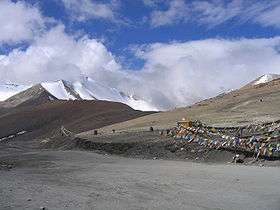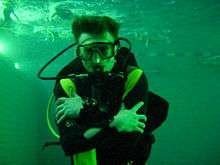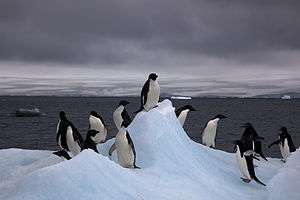Cold




How cold
When I woke up this morning
it was very cold.
How cold was it?
It was a freezing, sneezing
goose-bumpy, teeth-chattering,
can't-get-out-of-bed,
blankets-over-my-head
kind of cold
Cold refers to the condition or subjective perception of having low temperature, the absence of heat.[note 1]
A lower bound to temperature is absolute zero, defined as 0 K on the Kelvin scale, an absolute thermodynamic temperature scale. This corresponds to −273.15 °C on the Celsius scale, −459.67 °F on the Fahrenheit scale, and 0 °R on the Rankine scale.
Since temperature relates to the thermal energy held by an object or a sample of matter, which is the kinetic energy of the random motion of the particle constituents of matter, an object will have less thermal energy when it is colder and more when it is hotter. If it were possible to cool a system to absolute zero, all motion of the particles in a sample of matter would cease and they would be at complete rest in this classical sense. The object would be described as having zero thermal energy. Microscopically in the description of quantum mechanics, however, matter still has zero-point energy even at absolute zero, because of the uncertainty principle.
Cooling
Cooling refers to the process of becoming cold, or lowering in temperature. This could be accomplished by removing heat from a system, or exposing the system to an environment with a lower temperature.
Fluids used to cool objects are commonly called coolants.
Air cooling is the process of cooling an object by exposing it to air. This will only work if the air is at a lower temperature than the object, and the process can be enhanced by increasing the surface area or decreasing the mass of the object.
Another common method of cooling is exposing an object to ice, dry ice, or liquid nitrogen. This works by convection; the heat is transferred from the relatively warm object to the relatively cold coolant.
Laser cooling and Magnetic evaporative cooling are techniques used to reach very low temperatures.
Early History
In ancient times, ice was not adopted for food preservation but used to cool wine which the Romans had also done. According to Pliny, Emperor Niro invented the ice bucket to chill wines instead of adding it to wine to make it cold as it would dilute it.[5]
Some time around 1700 BC Zimrilim, king of Mari Kingdom in northwest Iraq had created an "icehouse" called bit shurpin at a location close to his capital city on the banks of the Euphrates. In the 7th century BC the Chinese had used icehouses to preserve vegetables and fruits. During the Tang dynastic rule in China (618 -907 AD) a document refers to the practice of using ice that was in vogue during the Eastern Chou Dynasty (770 -256 BC) by 94 workmen employed for "Ice-Service" to freeze everything from wine to dead bodies.[5]
Shachtman says that in the 4th century AD, Nintoku, Japanese Emperor was given a gift by his brother of ice from a mountain. The Emperor was so happy with the gift that he named the first of June as the "Day of Ice" and ceremoniously gave blocks of ice to his officials.[5]
Even in ancient times, Shachtman says, in Egypt and India, night cooling by evaporation of water and heat radiation, and the ability of salts to lower the freezing temperature of water was practiced. The ancient people of Rome and Greece were aware that boiled water cooled quicker than the ordinary water; the reason for this is that with boiling of water carbon dioxide and other gases, which are deterrents to cooling, are removed; but this fact was not known till the 17th century.[5]
History from 17th century
According to Tom Shachtman, till early seventeenth century cold was considered a mystery without source which was linked with death; inexplicable and too fearsome to investigate. Refrigeration by artificial means was an abhorrent idea as the thinking was for natural refrigeration though lot of consumable goods perished without any effort towards refrigeration. In the early 1700s no body tried to improve the efficacy of health, transportation or communications by mastering the knowledge of cold nor was there any effort to improve the comfort level of people by proper adoption of cold. The reasons for conversion of snow in the heavens into water, on the earth, reason for formation of snowflakes, its slippery characteristics were not fathomed. Snow measurements were not known.[6]
Shachtman says it was Cornelis Jackabszoon Drebbel who was appointed in 1608 by James Stuart, King of England who believed in magicians to perform magical tricks such as to produce thunder lightning, lions, birds, trembling leaves and so forth. It was Drebble, in 1620, who demonstrated an experiment in the Westminster Abbey to the king and his courtiers on the power of cold.[7] On a summer day, Shachtman says, Drebbel had created a chill (lowered the temperature by several degrees) in the hall of the Abbey which made the king to shiver and run out of the hall with his entourage. This was an incredible spectacle, says Shachtman. On an earlier occasion several years back Giambattista dells Porta had demonstrated at the Abbey "ice fantasy gardens, intricate ice sculptures" and also iced drinks for banquets in Florence. The only reference to the artificial freezing created by Drebble was in a reference by Francis Bacon. His demonstration was not taken seriously as it was considered as one of his magic tricks, as there was no practical application then. Drebble had not revealed his secrets.[8]
Lord Chancellor Bacon, says Shachtman, who was advocating experimental science had in the publication Navum Organum published in the later part of 1620s had made an attempt to explain the artificial freezing experiment at Westminster Abbey, though he was not present during the demonstration, as "Nitre (or rather its spirit) is very cold, and hence nitre or salt when added to snow or ice intensifies the cold of the latter, the nitre by adding to its own cold, but the salt by supplying activity to the cold snow." This explanation on the cold inducing aspects of nitre (now known as potassium nitrate) and salt was tried then by many scientists.[9]
Shachtman says it was the lack of scientific knowledge in physics and chemistry that had held back progress in use of ice for beneficial purposes till the awakening came in the 17th century, brought about by a drastic change in societal transformation in religious thoughts. The intellectual barrier was broken by Francis Bacon and Robert Boyle who followed him in this quest for knowledge of cold.[10] Boyle did extensive experimentation during the 17th century in the discipline of cold, and his research which related to pressure and volume, was the forerunner of research in the field of cold during the 19th century. He explained his approach as "Bacon's identification of heat and cold as the right and left hands of nature".[11]
Physiological effects
Cold has numerous physiological and pathological effects on the human body, as well as on other organisms. Cold environments may promote certain psychological traits, as well as having direct effects on the ability to move. Shivering is one of the first physiological responses to cold.[12] Extreme cold temperatures may lead to frostbite, sepsis, and hypothermia, which in turn may result in death.[13]
Notable cold locations and objects
.jpg)
- The coldest known temperature ever achieved is a state of matter called the Bose–Einstein condensate which was first theorized to exist by Satyendra Nath Bose in 1924 and first created by Eric Cornell, Carl Wieman, and co-workers at JILA on June 5, 1995. They did this by cooling a dilute vapor consisting of approximately two thousand rubidium-87 atoms to below 170 nK (one nK or nano K is a billionth (10−9) of a Kelvin) using a combination of laser cooling (a technique that won its inventors Steven Chu, Claude Cohen-Tannoudji, and William D. Phillips the 1997 Nobel Prize in Physics) and magnetic evaporative cooling.[14]
- The Boomerang Nebula is the coldest known natural location in the universe, with a temperature that is estimated at 1 K (−272.15 °C/−457.87 °F).[15]
- The Planck spacecraft's instruments are kept at 0.1 K (−273.05 °C/−459.49 °F) via passive and active cooling.[16]
- Absent any other source of heat, the temperature of the Universe is roughly 2.725 kelvin, due to the Cosmic microwave background radiation, a remnant of the Big Bang.[17]
- Neptune's moon Triton has a surface temperature of −235 °C (−391 °F)[18]
- Uranus with a black-body temperature of 58.2 K (−215.0 °C, −354.9 °F).[19]
- Saturn with a black-body temperature of 81.1 K (−192.0 °C, −313.7 °F).[20]
- Mercury, despite being close to the Sun, is actually cold during its night, with a temperature of about −180 °C (−290 °F). Mercury is cold during its night because it has no atmosphere to trap in heat from the Sun.[21]
- Jupiter with a black-body temperature of 110.0 K (−163.2 °C, −261.67 °F).[22]
- Mars with a black-body temperature of 210.1 K (−63.05 °C, −81.49 °F).[23]

- The coldest continent on Earth is Antarctica.[24] The coldest place on Earth is the Antarctic Plateau,[25] an area of Antarctica around the South Pole that has an altitude of around 3,000 metres (9,800 ft). The lowest reliably measured temperature on Earth of 183.9 K (−89.2 °C, −128.6 °F) was recorded there at Vostok Station on July 21, 1983[26] The Poles of Cold are the places in the Southern and Northern Hemispheres where the lowest air temperatures have been recorded. (See List of weather records).[27]
- Cold Deserts of the Himalayas are a feature of a rain-shadow zone created by the mountain peaks of the Himalaya range that runs from Pamir Knot extending to the southern border of the Tibetan plateau; however this mountain range is also the reason for the monsoon rain fall in the Indian subcontinent. This zone is located in an elevation of about 3,000 m, and covers Ladakh, Lahaul, Spiti and Pooh. In addition, there are inner valleys within the main Himalayas such as Chamoli, some areas of Kinnaur, Pithoragarh and northern Sikkim which are also categorized as cold deserts.[28]
Mythology and culture
- Niflheim was a realm of primordial ice and cold with nine frozen rivers in Norse Mythology.[29]
- The "Hell in Dante's Inferno" is stated as Cocytus a frozen lake where Virgil and Dante were deposited.[30]
See also
- Technical, scientific
- Entertainment, myth
- Meteorological:
- Geographical and climatological:
Notes
References
- ↑ Portal "Argonaut": Sygnały ręczne
- ↑ Scuba Diving – Hand Signals – strona w języku angielskim
- ↑ Diving Hand Signals (Additional signals) – strona w języku angielskim
- ↑ Barclay & Donato 1999, p. 1.
- 1 2 3 4 Shachtman 2000, p. 17.
- ↑ Shachtman 2000, p. 2.
- ↑ Shachtman 2000, p. 4.
- ↑ Shachtman 2000, pp. 8-9.
- ↑ Shachtman 2000, pp. 12-13.
- ↑ Shachtman 2000, pp. 18-25.
- ↑ Shachtman 2000, pp. 25-26.
- ↑ Mayo Clinic staff. "Hypothermia: Symptoms". Mayo Clinic. Retrieved February 15, 2016.
- ↑ Ellen Goldbaum (February 2, 2016). "Shocked by frostbite amputations, med students take action". UB Reporter. Retrieved February 15, 2016.
- ↑ "The Nobel Prize in Physics 1997".
- ↑ "Boomerang Nebula boasts the coolest spot in the Universe". NASA's Jet Propulsion Laboratory. June 20, 1997. Retrieved July 8, 2009.
- ↑ Staff (July 7, 2009). "Coldest Known Object in Space Is Very Unnatural". Space.com. Retrieved July 3, 2013.
- ↑ Hinshaw, Gary (December 15, 2005). "Tests of the Big Bang: The CMB". NASA WMAP. Retrieved January 9, 2007.
- ↑ "Voyager the Interstellar Mission". NASA: Jet Propulsion Laboratory, California Institute of Technology. Retrieved February 15, 2016.
- ↑ "Uranus Fact Sheet".
- ↑ "Saturn Fact Sheet".
- ↑ "Mercury: In Depth". NASA. Retrieved February 15, 2016.
- ↑ "Jupiter Fact Sheet".
- ↑ "Mars Fact Sheet".
- ↑ "Melting Ice in Antarctica : Image of the Day".
- ↑ Bignell, Paul (January 21, 2007). "Polar explorers reach coldest place on Earth". The Independent (London). Archived from the original on January 8, 2012. Retrieved April 30, 2010.
- ↑ Budretsky, A.B. (1984). "New absolute minimum of air temperature". Bulletin of the Soviet Antarctic Expedition (in Russian) (Leningrad: Gidrometeoizdat) (105).
- ↑ Sean O'Hare (January 22, 2013). "Welcome to the coldest village on Earth where the temperature can hit -71.2C, mobiles don't work... but homes still have outside toilets". Daily Mail. Retrieved February 15, 2016.
- ↑ Negi 2002, p. 9.
- ↑ Toole 2015, p. 118.
- ↑ Fowlie 1981, p. 198.
Bibliography
- Barclay, Jane; Donato, Janice (1999). How Cold Was It?. Lobster Press. ISBN 978-1-894222-03-7.
- Fowlie, Wallace (May 15, 1981). A Reading of Dante's Inferno. University of Chicago Press. ISBN 978-0-226-25888-1.
- Negi, S.S. (2002). Cold Deserts of India. Indus Publishing. ISBN 978-81-7387-127-6.
- Shachtman, Tom (12 December 2000). Absolute Zero and the Conquest of Cold. Houghton Mifflin Harcourt. ISBN 0-547-52595-8.
- Toole, S. J. (June 23, 2015). Origin Myth of Me: Reflections of Our Origins Creation of the Lulu. Lulu.com. ISBN 978-1-329-22607-4.
External links
- Shachtman, Tom (December 12, 2000). Absolute Zero and the Conquest of Cold. Houghton Mifflin Harcourt. ISBN 0-547-52595-8.
- Soldier's Handbook for Individual Operations and Survival in Cold-Weather Areas. Smashbooks.
- Wagner, Tom (March 28, 2008). "Tips for Surviving in Antarctica". The New York Times. ISSN 0362-4331. Retrieved February 15, 2016.


